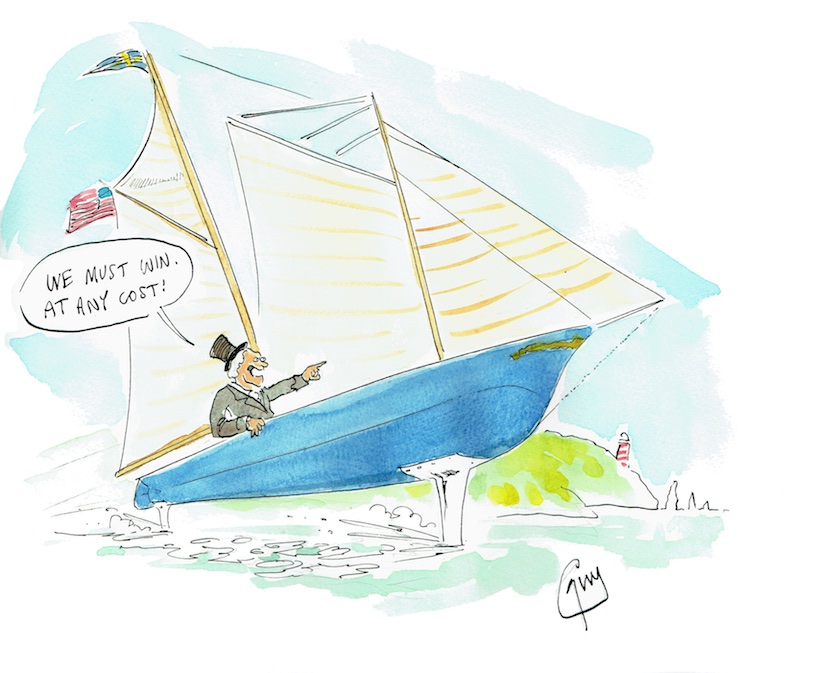‘The 500% increase in speed was not linear over the 164 years’
I am only too keenly aware that there are many of you reading this who know very much more than I know, or will ever know about the subjects on which I’ll be writing. My experience as a Classic Sailor might span over 50 years, as the first boat I skippered was a gaff cutter and my current boat, Maggie May, is a gaff yawl but in between I have been an advocate of bermudan rig and until three years ago all the boats I owned, with the exception of a gunter-rigged Heron dinghy, have been so rigged.
However, I would argue that a Classic Sailor is not defined by the rig that he or she sails under but by the techniques employed to sail and navigate those boats: anchoring is anchoring, navigating is navigating and getting out of (and into) trouble happens whether or not you’ve got many feet of varnished spruce at the masthead.
The carbon-fibre AC45s
probably weigh little
more than the armament
carried by America
I learned the skills of practical navigation and seamanship at the elbows of people whom I consider to have been some of the finest navigators and seamen afloat. The amount I gleaned by working with Des Sleightholme when he was Editor of Yachting Monthly would be too great to fill a volume of the Admiralty Manual of Seamanship. Indeed Des effectively tore up the traditional manuals and re-interpreted them in a form that was much more relevant and practical for the small boat sailor. It was he who introduced the concept of practical seamanship features and this theme continues in YM today.
All of this might seem a million miles and a million years away from the recent trials for the America’s Cup which were held off Portsmouth in foiling catamarans in July but it illustrates how yacht design and sailing techniques have evolved since the Cup was first contested in 1851.
These catamarans are capable of speeds of up to 40 knots. This means that two of these boats heading towards each other at full tilt will have a closing speed of more than 90 miles per hour.
Quite what New York Yacht Club Commodore John Cox Stevens, who chartered the gaff schooner America in 1851 to challenge for the 100 Sovereign Cup, would have made of this is anyone’s guess – disbelief and incredulity I suspect, that 164 years later this very same event should be raced in machines that fly.
Here are a few interesting comparisons. America was wooden, 101ft (30.8m) overall and displaced 100 tons. Although she was, in her way, revolutionary in terms of design and construction, it’s unlikely that her maximum speed would have been much into double figures. She won the Hundred Sovereign Cup, later to become the America’s Cup, in a race round the Isle of Wight, by a margin of 18 minutes. By comparison the carbon fibre AC45s weigh in at around 1300kg, probably little more than the armament, two 24 pound and one 12 pound cannon, carried by America.
Such comparisons are meaningless unless taken in context. The 500% increase in speed was not linear across those 164 years, indeed it is probable that the boats competing up to 1983, the era of the Twelve Metres and the year that Alan Bond’s Australia II, skippered by John Bertrand, wrested the Cup from the arms of the New York Yacht Club, that speeds had not increased substantially, if at all. Races were won and lost by fractions of a knot. This was the era of the ‘lead mines’, boat with such enormous ballast ratio that they could sit upright on their keels ashore with only vestigial support.
I’m not attempting a history of the America’s Cup here, others have done that at very great length already, but after some challenges – best described as ugly, a new class emerged – the International America’s Cup Class, which was raced between 1992 and 2007. These too were lead mines and after another unsightly challenge, this time in multihulls, in 2010 which took place as much in the courts as it did on the course, Larry Ellison took the Cup with him back to San Francisco where, in 2013, the America’s Cup was raced for the first time in foiling catamarans: the AC72s. The challenger was Emirates Team New Zealand and the defender Oracle Team USA. Their top speed of over 30 knots was then considered pretty awesome.
The result is history. The Americans came back from 1 – 8 down to take eight straight races and win the Cup. Their change in fortune also came when a new strategist, one Ben Ainslie, stepped on board. And now we have 45-footers capable of 40 knots.
There might seem little relevance of this to the Classic Sailor except that it illustrates the way evolution is design and construction can take place over a very short period of time. You might think that ultimate speed is not really a part of his or her vocabulary and you know what? You’d be quite right. But to watch these new foiling catamarans flying along at such high speeds is just breathtaking, whether you’re a classic or a hi-tech sailor. ★


